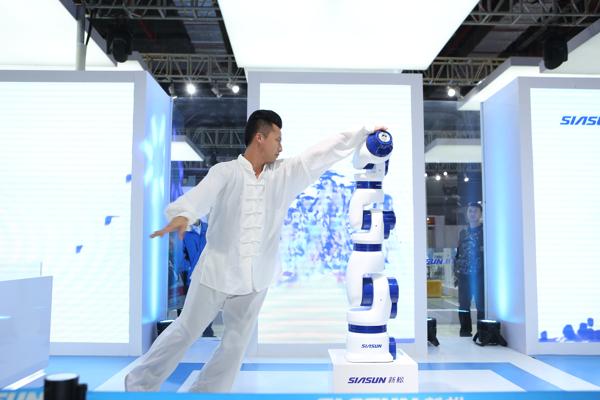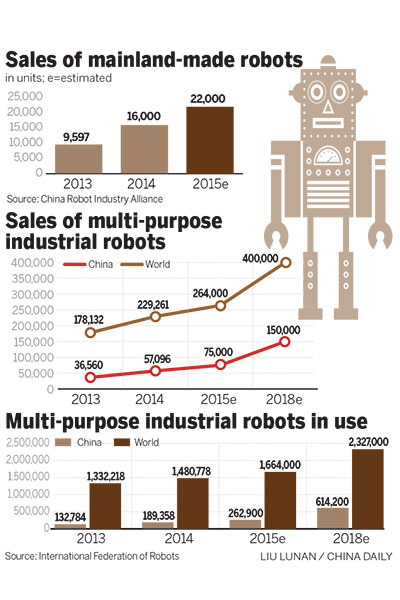
A martial arts master plays Taichi with a robot at a smart manufacturing expo in Shanghai. Developed by Siasun Robot & Automation Co, it is China’s first homegrown seven-axis collaborative robot, and was one of the star attractions at expos in Beijing and Shanghai.[Photo/Provided to China Daily]
As China embraces automation, the wide technology gap between local and foreign robot makers is narrowing slowly but surely
In a glitzy exhibition hall in Beijing, an extraordinary Tai chi show is on. The performers are a martial arts master in spotless white robes and-wait for it-an industrial robot.
It’s the kind of robot you would often see hiding behind safety barriers at factories.
No sooner had the master pushed his right hand against the robot than the latter sprung into action, circled around and smoothly pushed him back in one fluid motion.
The 90-second demo is more ballet than combat as the man and the machine engage in almost intimate motions. Every time the master comes into contact, the sensor-rich machine, well, senses the touch instantly, determines the amount of pressure in it and ‘instinctively’ moves in the intended direction.
“This is China’s first homegrown seven-axis collaborative robot,” said Qu Daokui, president of Siasun Robot & Automation Co, the manufacturer of the motorized arm.
It can be trained by hands to perform a string of industrial tasks like grinding, packaging and feeding parts.
“It is ready to work side by side with humans on assembly lines, performing a string of industrial tasks like grinding, packaging, assembling and feeding parts,” he said.
The collaborative robot, which was unveiled in November, is part of a broad effort by Siasun, as well as its domestic peers, to cash in on the country’s growing appetite for industrial robots as enterprises are cranking up automation of car and electronics factories.

The world’s second-largest economy is already the leading market for industrial robots, accounting for a quarter of global sales, according to the International Federation of Robotics.
Between 2010 and 2014, total supply of industrial robots in China increased by about 40 percent per year on average.
“This (China’s) rapid development is unique in the history of robotics. There has never been such dynamic rise in such a short period of time in any other market,” IFR said in a report.
But still, for every 10,000 employees, there are only 36 robots in China, compared with 478 in South Korea, 292 in Germany and 164 in the United States in 2014.
As the surging labor cost is pushing more enterprises to embrace robots, IFR estimates China will account for more than one-third of the industrial robots installed worldwide in 2018, more than doubling over the next two years-from 262, 900 now to 614,200.
Naturally, the growth prospect offers a golden opportunity for domestic robot manufacturers.
In addition to Siasun, the country’s largest robot maker by market value, a bunch of new players are getting lured in and many robot makers are upping the ante with ambitious development plans.
“The past two years have seen an explosion of domestic robot makers, partly stimulated by strong policy support,” said Luo Jun, chief executive officer of the International Robotics and Intelligent Equipment Industry Alliance, a Beijing-based industry association.
The robot industry is central to the country’s Made in China 2025 strategy designed to promote high-end manufacturing.
It is also highlighted in Beijing’s new five-year plan, which guides national economic development.

Kuka robot pours wine at a fair in Shanghai in November 2015.[Photo/Huang Zhengwei/China Daily]
One of the new entrants is HIT Robot Group, which was established in December 2014 with funding from a provincial government and the Harbin Institute of Technology, a Chinese university which was ranked 7th among the best global engineering universities by US News in 2015.
The elite university has done years of cutting-edge research into robots-it is the maker of China’s first space robots and lunar vehicle.
For its part, the company is positioned to have a presence in a wide range of areas, from robot components, industrial robots, service robots to automated equipment for nuclear power plants and aerospace industries.
“We have arguably the best robot engineers and researchers in China, which can give us an unparalleled advantage,” wrote Han Jiecai, honorary chairman of HIT Robot and vice president of the Harbin Institute of Technology, in a bylined article in the Economic Observer.
But despite the efforts by leading Chinese robot manufacturers to build a premium brand, most players are still locked in low-end competition, experts said.
“Though the domestic scientific community has been researching robots for many years, the robot industry is still in its infancy,” said Hao Yucheng, deputy director of the China Robot Industry Alliance.
“The bulk of enterprises have no intellectual properties, talents, and cash. They are just entering the sector with enthusiasm and doing repetitive jobs like assembling robots instead of making robots,” he said.
In 2014, China bought over 57,000 industrial robots, but less than 30 percent of them are from domestic suppliers, data from the China Robot Industry Alliance shows.
Foreign heavyweights including ABB Ltd, KUKA Robotics Corp and FANUC Corp are sharing the rest 70 percent of the market.
“China’s robot industry is like a toddler. But it is growing in the world’s largest robot market where many competitive foreign enterprises are scrambling for a pie. Opportunities abound, so do challenges. A simple mistake is likely to nip the industry in the bud,” Qu of Siasun said.
Also, a wide technological gap still exists between domestic robot manufacturers and their foreign counterparts.
China now has few enterprises that can provide mass produced and reliable industrial robot components such as speed reducers, drive and control devices, as well as servomotors.
“Most of these components are still imported from foreign countries, whose steep tariffs increase the cost of robots,” Hao of the China Robot Industry Alliance said.
For instance, speed reducers could account for about 30 percent of domestic robots’ cost, compared with only 12 percent for similar Japanese robots, an industry resource said.
But local enterprises are already accelerating steps to boost their capability in research and development as well as small-scale production of key robot components. Shaanxi Qinchuan Machinery Development Co Ltd, for instance, has poured 194 million yuan in 2013 into a robot speed reducer project, which can now produce 500 to 700 units per month.
“We are working on a mass production assembly line project. When completed, it will boost monthly production capacity to 5,000 units by the end of 2016,” the company said in a press release in November.
Siasun also expanded its presence in the niche by setting up a unit in May 2015.
It is planning to acquire competitive domestic and international component manufacturers after the Shenzhen-listed company raised 2.96 billion yuan from five institutional investors in November.
“We have been in negotiations with potential companies for over a year and we hope to complete the acquisition by June,” Qu, president of Siasun said, declining to offer more details.
“Our goal is not to catch up but to take the lead by innovating on the basis of state-of-the-art technologies,” he said.
